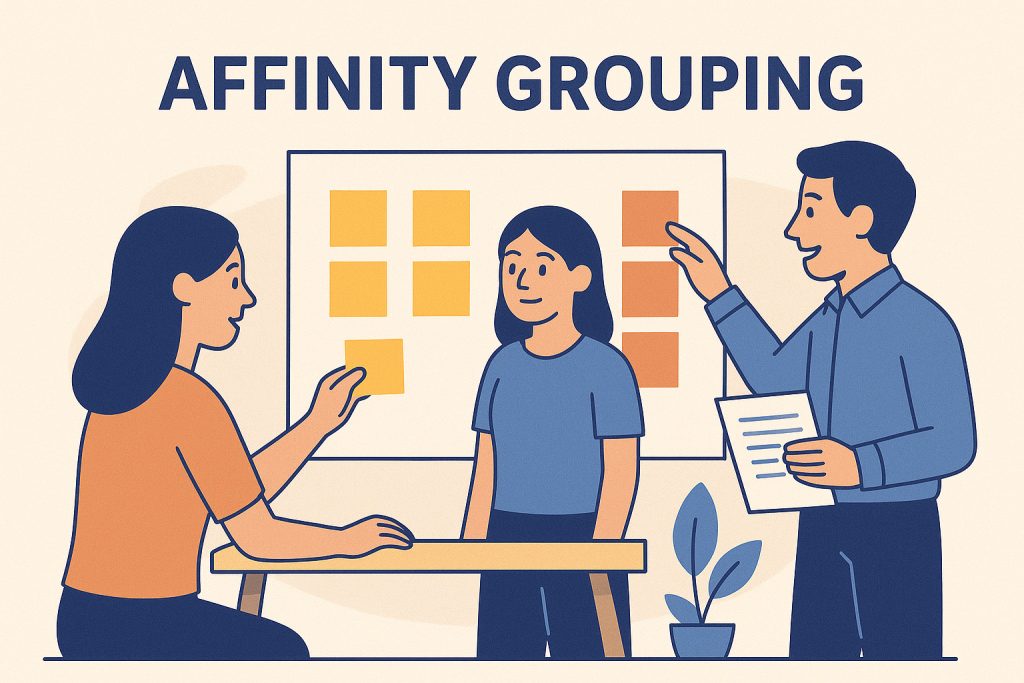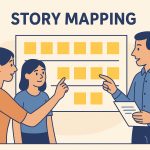In the fast-paced world of product development, teams constantly grapple with an abundance of ideas, feature requests, and strategic opportunities. The challenge isn’t usually a lack of innovation—it’s making sense of all the creative energy and deciding what deserves attention first. This is where affinity grouping emerges as a particularly elegant solution, transforming chaotic brainstorming sessions into structured, actionable priorities.
At its heart, affinity grouping represents a democratized approach to decision-making that harnesses collective intelligence while maintaining focus. Rather than leaving prioritization to a single decision-maker or relying on gut instinct, this method creates space for diverse perspectives to surface and naturally organize themselves into meaningful patterns.
What is Affinity Grouping?
Affinity grouping operates on a beautifully simple premise: similar ideas naturally cluster together, and these clusters reveal the themes that matter most to your team and organization. The process begins with unrestricted brainstorming, where participants capture their thoughts on individual sticky notes or cards. This divergent thinking phase encourages wild ideas and builds on the creative momentum of the group.
The magic happens in the convergent phase, where the team collaboratively sorts these individual ideas into groups based on natural relationships and shared themes. These emerging clusters—the affinity groups—represent the collective wisdom of the room about what belongs together. Once these thematic groupings crystallize, the team can evaluate and rank them according to their strategic importance or potential impact.
What makes this technique particularly powerful is its dual nature as both a brainstorming and prioritization tool. While traditional brainstorming often produces long lists that gather digital dust, affinity grouping creates immediate structure and momentum toward action. The collaborative sorting process itself generates valuable discussions about relationships between ideas, often revealing insights that wouldn’t emerge from individual analysis.
This method proves especially valuable for product managers navigating complex roadmap decisions. When stakeholders from different departments contribute their perspectives, the resulting affinity groups often reflect genuine cross-functional priorities rather than the loudest voice in the room. The visual nature of the process—seeing ideas physically grouped and regrouped—makes abstract concepts tangible and helps teams reach consensus more naturally.
How Do You Facilitate an Affinity Grouping Activity?
Successfully facilitating an affinity grouping session requires balancing structure with flexibility, ensuring every voice contributes while maintaining productive momentum. The beauty of this approach lies in its accessibility—you don’t need specialized training or expensive tools to create meaningful outcomes.
Setting the Stage
Begin by assembling a diverse group of participants who bring different perspectives to your challenge. This diversity proves crucial because people from various departments, experience levels, and roles will naturally think about problems differently. A product manager might focus on user experience, while a sales representative brings market feedback, and an engineer considers technical feasibility. This cognitive diversity enriches the pool of ideas and leads to more robust prioritization.
Create an environment that encourages open thinking. Physical space matters—arrange seating so everyone can see and interact with the emerging groups of ideas. If working remotely, ensure your digital collaboration tool allows for easy manipulation of virtual sticky notes and clear visibility for all participants.
The Brainstorming Phase
Launch with focused brainstorming around your specific challenge or question. Encourage participants to write one idea per sticky note, keeping thoughts concise but complete enough for others to understand. The goal is quantity over quality at this stage—wild ideas often spark practical innovations, and seemingly obvious suggestions might reveal overlooked opportunities.
Maintain energy by setting time boundaries and encouraging rapid idea generation. When the flow of new ideas naturally slows, you’ve likely captured the initial creative burst. Resist the urge to evaluate or discuss ideas during this phase—that comes later.
Collaborative Grouping
The sorting phase transforms individual creativity into collective insight. Invite participants to begin clustering ideas that seem related, but avoid imposing predetermined categories. Let the natural relationships emerge through group discussion and gentle negotiation. This organic process often reveals unexpected connections and helps teams discover themes they hadn’t consciously recognized.
Encourage participants to move sticky notes freely and discuss their reasoning. When disagreements arise about where an idea belongs, these conversations often prove most valuable—they surface different perspectives on the same concept and can lead to breakthrough insights about priorities.
Voting and Ranking
Once stable groups emerge, facilitate a voting process to rank their relative importance. You might give each participant a limited number of votes to distribute across groups, or use techniques like dot voting where people place stickers on their preferred themes. The key is creating a system that prevents any single person from dominating the prioritization while ensuring everyone’s voice contributes to the final ranking.
Consider the context when designing your voting mechanism. Are you trying to identify the single most important theme, or do you need to understand the relative priority of multiple initiatives? Your voting structure should align with how you plan to use the results.
When Should You Use Affinity Grouping?
Affinity grouping shines brightest when teams face complex prioritization challenges that benefit from diverse input and collaborative decision-making. Product managers often discover this technique most valuable during roadmap planning sessions, where competing priorities and stakeholder interests create decision paralysis.
Ideal Scenarios for Implementation
The method proves particularly effective when you’re dealing with a large volume of potential features, improvements, or strategic initiatives. Rather than attempting to rank dozens of individual ideas, affinity grouping helps you identify the major themes and priority areas that should guide your planning. This higher-level perspective often reveals strategic patterns that individual item prioritization might miss.
Consider affinity grouping when stakeholder alignment proves challenging. The collaborative nature of the process creates shared ownership of the results, making it easier to gain buy-in for the prioritized themes. When marketing, sales, engineering, and product teams participate together, the resulting priorities reflect genuine cross-functional consensus rather than one department’s perspective.
The technique also excels in situations where you need to balance innovation with execution. By grouping related ideas together, teams can identify clusters that combine quick wins with longer-term strategic investments, creating roadmaps that maintain momentum while building toward bigger goals.
Benefits Beyond Prioritization
- Knowledge sharing across teams: Different departments learn about each other’s priorities and constraints, fostering better collaboration in future projects
- Identification of unexpected connections: Ideas that seemed unrelated individually often reveal strategic relationships when grouped thematically
- Democratic decision-making: Every participant contributes equally to both idea generation and prioritization, reducing the influence of hierarchy or politics on product decisions
Successful affinity grouping sessions often generate energy and alignment that extends well beyond the immediate prioritization decisions. Teams report feeling more connected to the chosen priorities because they participated in discovering them, rather than having them imposed from above. This sense of ownership translates into stronger execution and more innovative problem-solving as projects move forward.
The visual and collaborative nature of affinity grouping creates shared mental models that persist after the session ends. When teams reference “the customer experience cluster” or “the technical debt group” in future discussions, everyone understands not just what those categories contain, but why they emerged as priorities and how they relate to other themes. This common language accelerates future decision-making and helps maintain strategic focus as circumstances evolve.
Affinity grouping represents more than just another prioritization technique—it embodies a philosophy of collaborative intelligence that recognizes the wisdom inherent in diverse perspectives. In an era where product decisions grow increasingly complex and stakeholder expectations continue rising, methods that democratize strategic thinking while maintaining focus become essential tools for effective leadership.
Conclusion
The real power of affinity grouping lies not in its simplicity, but in its ability to transform the messy reality of competing priorities into clear, actionable direction. By honoring both individual creativity and collective wisdom, this technique creates prioritization decisions that teams actually want to execute.
What sets affinity grouping apart from other prioritization methods is its inherent respect for the collaborative process itself. Rather than rushing toward quick decisions, it creates space for ideas to breathe, evolve, and find their natural relationships with other concepts. This patience often yields surprising insights—connections that no individual would have made alone, priorities that emerge from the collective intelligence of diverse perspectives.
The technique also builds organizational muscle memory for better decision-making. Teams that regularly practice affinity grouping develop stronger skills in listening, synthesizing different viewpoints, and finding common ground. These capabilities extend far beyond product roadmapping into areas like strategic planning, problem-solving, and conflict resolution.
In a world overflowing with good ideas, the ability to collaboratively identify what matters most may be the most valuable skill a product team can develop. Affinity grouping doesn’t just help teams choose better priorities—it helps them become better at the ongoing work of turning possibilities into reality.


